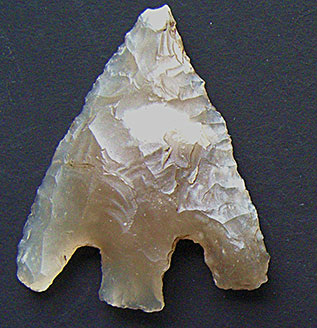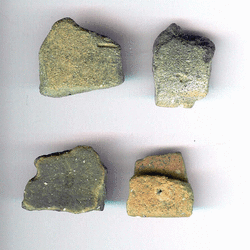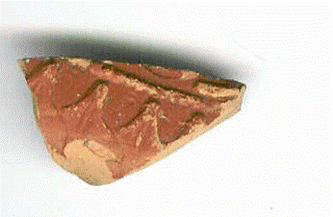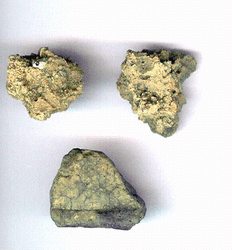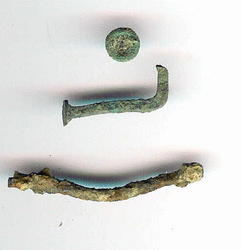Several small small scale digs were done in Avalanche Road
A small exploratory dig was done on rough pasture land at the rear of houses in Avalanche Road used for keeping horses.
Finds included a particularly fine tanged arrow head beautifully formed from flint. Picture below is not the actual artefact which unfortunately was lost, but in all other respects is identical.
A small exploratory dig was done on rough pasture land at the rear of houses in Avalanche Road used for keeping horses.
Finds included a particularly fine tanged arrow head beautifully formed from flint. Picture below is not the actual artefact which unfortunately was lost, but in all other respects is identical.
Another dig was done in a back garden
Members of the Association for Portland Archaeology, led by Denene Reilly, carried out an excavation between June and August in 2001. The aim of the excavation was to discover if any archaeological evidence remained associated with a burial which was excavated in the 1970’s when new housing was constructed to the rear of the existing properties in Avalanche Road. The excavation was also to provide practice and experience in excavation techniques.
A trial trench was dug in the garden at the rear of 49 Avalanche Road adjacent to the reported location of the Roman burial which lay outside the property boundary. The trench was 3m by 1.5m Top soil of light brown/gray approximately 25cm deep was excavated from the trench. This layer had been in use for the last hundred years first as a vegetable plot and latterly as a dump for domestic refuse. The disturbed top soil yielded finds almost entirely from the nineteenth and twentieth centuries
Layer One comprises a dark brown/gray soil with a scatter of small stones and extended to a depth of 45cm. Layer two extended to a depth of 65cm and comprised a yellow/brown silty clay. These two layers yielded over one hundred pottery shards dated mostly to the Roman period ranging from domestic pots (Fig. 1) to the finest Samian Ware.(Fig 2)
One shard of Iron Age pottery was also excavated in association with two fragments of possibly burnt daub. Fig 3) Some metal finds were also excavated from these layers including a Iron brooch pin and a Bronze/Alloy stud and catch possibly from a wooden box. (Fig. 4).
Layer Three was a natural deposit of a solid yellow/green clay laying over a natural salt bed. No features or structural evidence was excavated in the trench but the number of pottery shards indicates the presence of a Roman settlement on Avalanche Road.
Members of the Association for Portland Archaeology, led by Denene Reilly, carried out an excavation between June and August in 2001. The aim of the excavation was to discover if any archaeological evidence remained associated with a burial which was excavated in the 1970’s when new housing was constructed to the rear of the existing properties in Avalanche Road. The excavation was also to provide practice and experience in excavation techniques.
A trial trench was dug in the garden at the rear of 49 Avalanche Road adjacent to the reported location of the Roman burial which lay outside the property boundary. The trench was 3m by 1.5m Top soil of light brown/gray approximately 25cm deep was excavated from the trench. This layer had been in use for the last hundred years first as a vegetable plot and latterly as a dump for domestic refuse. The disturbed top soil yielded finds almost entirely from the nineteenth and twentieth centuries
Layer One comprises a dark brown/gray soil with a scatter of small stones and extended to a depth of 45cm. Layer two extended to a depth of 65cm and comprised a yellow/brown silty clay. These two layers yielded over one hundred pottery shards dated mostly to the Roman period ranging from domestic pots (Fig. 1) to the finest Samian Ware.(Fig 2)
One shard of Iron Age pottery was also excavated in association with two fragments of possibly burnt daub. Fig 3) Some metal finds were also excavated from these layers including a Iron brooch pin and a Bronze/Alloy stud and catch possibly from a wooden box. (Fig. 4).
Layer Three was a natural deposit of a solid yellow/green clay laying over a natural salt bed. No features or structural evidence was excavated in the trench but the number of pottery shards indicates the presence of a Roman settlement on Avalanche Road.
